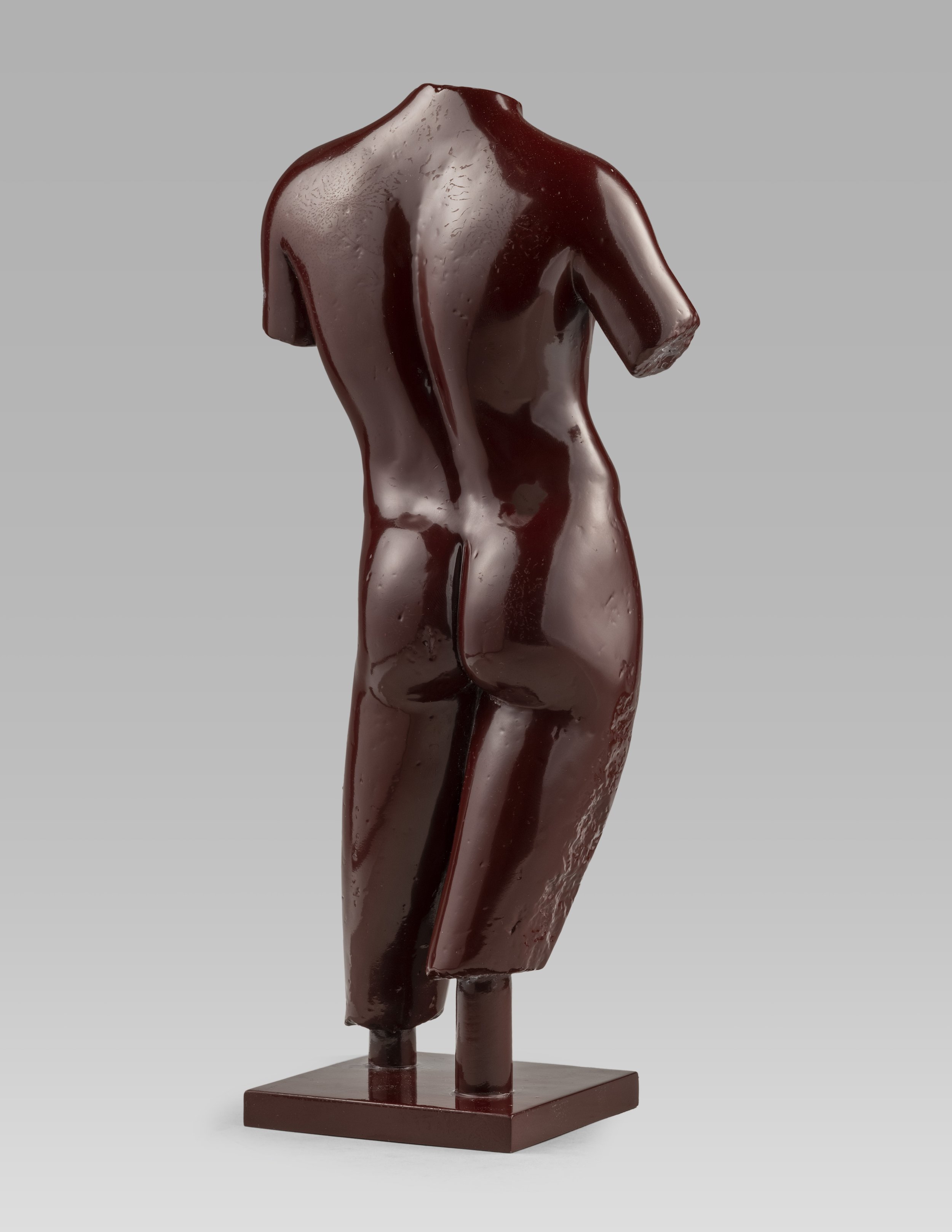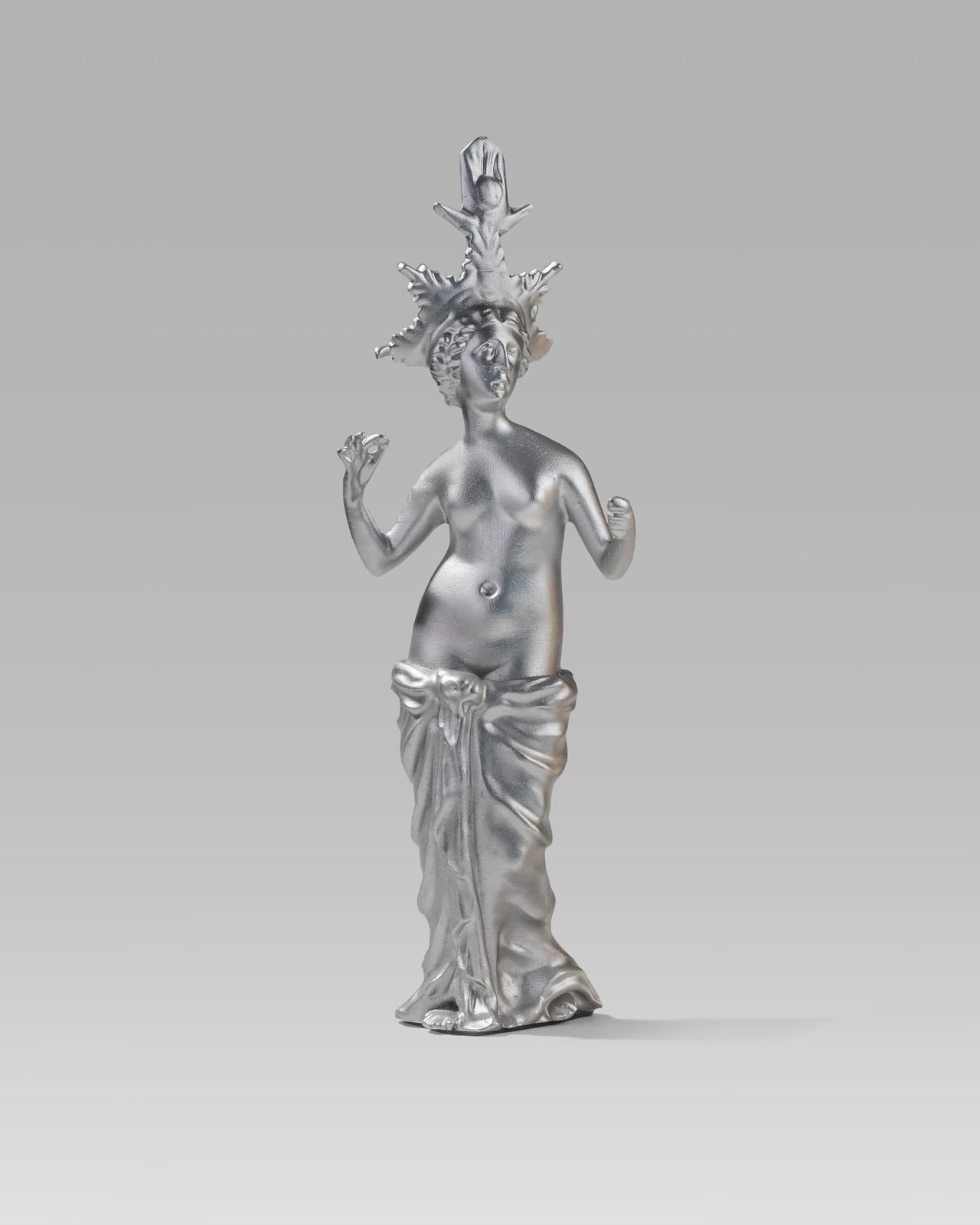 Image 1 of 2
Image 1 of 2

 Image 2 of 2
Image 2 of 2



Colossal "Naxos" Cycladic Idol
This 4-foot tall polyresin Cycladic idol is inspired by the mysterious art of an ancient civilization. The brazen and blazing red gold on the left is a luxurious reimagined artwork built for the future. On the right, encrustations and a deep marble color take you back to the ancient civilization in the Cyclades.
The original marble idol is from the Early Cycladic II period, circa 2500 to 2400 B.C. These idols come from the Greek islands that made up the Cyclades. Most major museums pride themselves on having at least one great example.
This masterpiece is attributed to the Naxos Museum Sculptor of the Spedos variety; the most widespread variety of Cycladic idols. In some cases, red and blue pigments indicated the details such as eyes and the hairline; when survived, the almond-shaped eyes have dotted pupils.
Cycladic marble idols are generally represented as a reclining folded-arm female figure and originate from the geographic areas of the Cyclades in the Aegean Sea. Cycladic art is famous mostly for these statuettes, whose design is both simple and attractive, appealing to the modern artistic eye.
This statuette has slightly protruding breasts; the legs are slightly bent, arms folded over the belly. The head is tilted backwards, its flared oval profile recalls the shape of a lyre. Only the straight nose is sculpted on the face. The proportions of the figure are elegant and subtle; the rounded line of the shoulders is particularly fine. Incisions highlight the nape, the base of the neck. The deep notch between the legs shows an elongated opening between the knees.
This 4-foot tall polyresin Cycladic idol is inspired by the mysterious art of an ancient civilization. The brazen and blazing red gold on the left is a luxurious reimagined artwork built for the future. On the right, encrustations and a deep marble color take you back to the ancient civilization in the Cyclades.
The original marble idol is from the Early Cycladic II period, circa 2500 to 2400 B.C. These idols come from the Greek islands that made up the Cyclades. Most major museums pride themselves on having at least one great example.
This masterpiece is attributed to the Naxos Museum Sculptor of the Spedos variety; the most widespread variety of Cycladic idols. In some cases, red and blue pigments indicated the details such as eyes and the hairline; when survived, the almond-shaped eyes have dotted pupils.
Cycladic marble idols are generally represented as a reclining folded-arm female figure and originate from the geographic areas of the Cyclades in the Aegean Sea. Cycladic art is famous mostly for these statuettes, whose design is both simple and attractive, appealing to the modern artistic eye.
This statuette has slightly protruding breasts; the legs are slightly bent, arms folded over the belly. The head is tilted backwards, its flared oval profile recalls the shape of a lyre. Only the straight nose is sculpted on the face. The proportions of the figure are elegant and subtle; the rounded line of the shoulders is particularly fine. Incisions highlight the nape, the base of the neck. The deep notch between the legs shows an elongated opening between the knees.
This 4-foot tall polyresin Cycladic idol is inspired by the mysterious art of an ancient civilization. The brazen and blazing red gold on the left is a luxurious reimagined artwork built for the future. On the right, encrustations and a deep marble color take you back to the ancient civilization in the Cyclades.
The original marble idol is from the Early Cycladic II period, circa 2500 to 2400 B.C. These idols come from the Greek islands that made up the Cyclades. Most major museums pride themselves on having at least one great example.
This masterpiece is attributed to the Naxos Museum Sculptor of the Spedos variety; the most widespread variety of Cycladic idols. In some cases, red and blue pigments indicated the details such as eyes and the hairline; when survived, the almond-shaped eyes have dotted pupils.
Cycladic marble idols are generally represented as a reclining folded-arm female figure and originate from the geographic areas of the Cyclades in the Aegean Sea. Cycladic art is famous mostly for these statuettes, whose design is both simple and attractive, appealing to the modern artistic eye.
This statuette has slightly protruding breasts; the legs are slightly bent, arms folded over the belly. The head is tilted backwards, its flared oval profile recalls the shape of a lyre. Only the straight nose is sculpted on the face. The proportions of the figure are elegant and subtle; the rounded line of the shoulders is particularly fine. Incisions highlight the nape, the base of the neck. The deep notch between the legs shows an elongated opening between the knees.
Original Ancient
Early Cycladic II period, ca. 2500 to 2400 B.C.
Marble
H: 21 cm (8.3 in)
Contempo
2025
Polyresin, Hand-Painted
Handcrafted Custom Steel Support Plate
H: 122 cm (122 inches)





